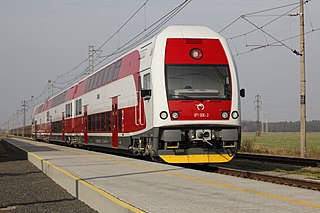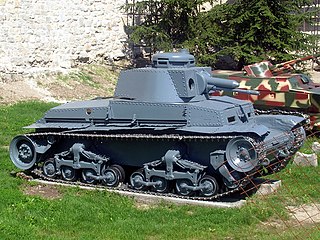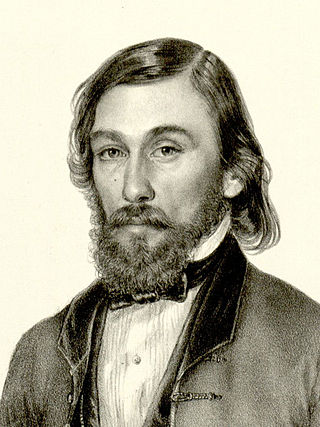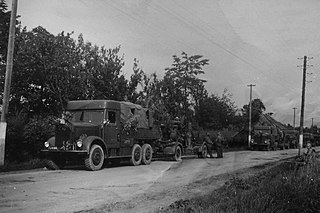
An armoured fighting vehicle or armored fighting vehicle (AFV) is an armed combat vehicle protected by armour, generally combining operational mobility with offensive and defensive capabilities. AFVs can be wheeled or tracked. Examples of AFVs are tanks, armoured cars, assault guns, self-propelled artilleries, infantry fighting vehicles (IFV), and armoured personnel carriers (APC).

Transport in Slovakia is possible by rail, road, air, or rivers. Slovakia is a developed Central European country with a well-developed rail network (3,662 km) and a highway system (854 km). The main international airport is the M. R. Štefánik Airport in the capital, Bratislava. The most important waterway is the river Danube, which is used by passenger, cargo, and freight ships. The two most important harbours in Slovakia are Komarno harbour and Bratislava harbour.

The Panzerkampfwagen 38(t), originally known as the ČKD LT vz. 38, was a tank designed during the 1930s, which saw extensive service during World War II. Developed in Czechoslovakia by ČKD, the type was adopted by Nazi Germany following the annexation of Czechoslovakia. With the German Army and other Axis forces, the type saw service in the invasions of Poland, France and the USSR. Production ended in 1942, when its main armament was deemed inadequate. In all, over 1,400 Pz. 38(t)s were manufactured. The chassis of the Pz. 38(t) continued to be produced for the Marder III (1942–1944) with some of its components used in the later Jagdpanzer 38 (1944–1945) tank destroyer and its derivative vehicles.

Ludevít Štúr, also known as Ľudovít Velislav Štúr, was a Slovak revolutionary, politician, and writer. As a leader of the Slovak national revival in the 19th century, and the author of the Slovak language standard, he is lauded as one of the most important figures in Slovak history.

Banská Bystrica is a city in central Slovakia, located on the Hron River in a long and wide valley encircled by the mountain chains of the Low Tatras, the Veľká Fatra, and the Kremnica Mountains. With approximately 76,000 inhabitants, Banská Bystrica is the sixth most populous municipality in Slovakia. The present-day town was founded by German settlers, invited by the Hungarian Árpád-kings, during the Middle Ages, however it was built upon a former Slavic/Slovakian/Avar settlement. A part of Zolyom county after the Hungarian conquest. During the reign of Béla IV of Hungary it obtained the municipal privileges of a free royal town of the Kingdom of Hungary in 1255 and resettled with Germans from Thüringen. The copper mining town acquired its present picturesque look in the late Middle Ages when the prosperous burghers built its central churches, mansions, and fortifications. It is the capital of the kraj and the okres. It is also the home of Matej Bel University. As a historical town with an easy access to the surrounding mountains, Banská Bystrica is a popular winter and summer tourist destination.

Zvolen is a city in central Slovakia, situated on the confluence of Hron and Slatina rivers. It is famous for several historical and cultural attractions. It is surrounded by Poľana mountain from the East, by Kremnické vrchy from the West and by Javorie and Štiavnické vrchy from the South.

The Panzerkampfwagen 35(t), commonly shortened to Panzer 35(t) or abbreviated as Pz.Kpfw. 35(t), was a Czechoslovak-designed light tank used mainly by Nazi Germany during World War II. The letter (t) stood for tschechisch (German for "Czech"). In Czechoslovak service, it had the formal designation Lehký tank vzor 35 (Light Tank Model 35), but was commonly referred to as the LT vz. 35 or LT-35.

Marder III was the name for a series of World War II German tank destroyers. They mounted either the modified ex-Soviet 76.2 mm F-22 Model 1936 divisional field gun, or the German 7.5 cm PaK 40, in an open-topped fighting compartment on top of the chassis of the Czechoslovakian Panzer 38(t). They offered little protection to the crew, but added significant firepower compared to contemporary German tanks. They were in production from 1942 to 1944, and served on all fronts until the end of the war, along with the similar Marder II. The German word Marder means "marten" in English.

An armoured train or armored train is a railway train protected with heavy metal plating and which often includes railway wagons armed with artillery, machine guns, and autocannons. Some also had slits used to fire small arms from the inside of the train, especially in earlier armoured trains. For the most part, they were used during the late 19th and early 20th centuries, when they offered an innovative way to quickly move large amounts of firepower into a new location. Most countries discontinued their use – road vehicles became much more powerful and offered more flexibility, train tracks proved too vulnerable to sabotage and attacks from the air, and air transportation was an even more flexible way to relocate firepower to a new location. However, there were occasional uses in the late 20th century and early 21st century Russian Federation used improvised armoured trains in the Second Chechen War (1999–2009) and the Russian invasion of Ukraine (2022–present).

The armored train Štefánik was a military train used during World War II in Slovakia.

The NI tank also known as the Odessa tank, was a Soviet improvised fighting vehicle, based on an STZ-5 agricultural tractor, manufactured in Odessa during the Siege of Odessa in World War II.

Budča is a village and municipality of the Zvolen District in the Banská Bystrica Region of Slovakia.

Jozef Miloslav Hurban was a leader of the Slovak National Council and the Slovak Uprising in 1848–1849. He was a writer, journalist, politician, organizer of Slovak cultural life, and a Lutheran pastor. He was a supporter of Ján Kollár, and later of Ľudovít Štúr. His son, Svetozár Hurban-Vajanský, followed in his footsteps both as a writer and nationalist.

The LT vz. 34, formally designated as Lehký tank vzor 34 was a Czechoslovak-designed light tank used mainly by Slovakia during World War II. Its suspension was based on that of the Carden-Loyd tankette, of which the Czechs had purchased three, plus a manufacturing license, in 1930. Dissatisfied with the prototypes of the Tančík vz. 33 tankette, the Czech Army decided that it would be easier to design a light tank from scratch rather than modify a tankette's chassis to carry a fully rotating armored turret. 50 were built, the last of which was delivered during 1936, of which the Germans captured 22 - including the prototype, when they occupied Bohemia-Moravia in March 1939, but they promptly scrapped them. The Slovaks seized the remaining 27 when they declared independence from Czechoslovakia at the same time. In Slovak service it only saw combat during the Slovak National Uprising.

The OA vz. 30 was a Czechoslovak-designed armored car used by Czechoslovakia in the 1930s and by Nazi Germany, Slovakia, Romania and Hungary during World War II. Fifty-one were built, of which the Germans seized twenty-four when they occupied Bohemia-Moravia in March 1939 and the Slovaks captured eighteen when they declared independence from Czechoslovakia at the same time. Romania acquired nine when Czech troops sought refuge in Romania after the Hungarian invasion of Carpatho-Ukraine that same month. Slovak vehicles saw combat in the Slovak-Hungarian War, the invasion of Poland, the opening months of Operation Barbarossa and the Slovak National Uprising.

The Slovak Uprising , Slovak Volunteer Campaigns or Slovak Revolt was an uprising of Slovaks in Western parts of Upper Hungary with the aim of equalizing Slovaks, democratizing political life and achieving social justice within the 1848–49 revolutions in the Habsburg Monarchy. It lasted from September 1848 to November 1849. In October 1848, Slovak leaders replaced their original Hungaro-federal program by Austro-federal, called for the separation of a Slovak district from the Kingdom of Hungary and for the formation of a new autonomous district within the framework of the Habsburg Monarchy.

Zvolen passenger railway station, also known as Zvolen main railway station, is the main passenger station serving the city of Zvolen, Zvolen District, located in Banská Bystrica Region, central Slovakia. It is an important railway junction in Slovakia.

This article deals with the history of tanks employed by military forces in Czechoslovakia from the interwar period, and the more conventional tanks designed for the Czechoslovak Army before World War II, and the tanks that ended up as Panzers of the German Wehrmacht during World War II, or in the use of other countries who purchased them before the war began.

The Slovak National Uprising was a military uprising organized by the Slovak resistance movement during World War II in central Slovakia. This resistance movement was represented mainly by members of the Democratic Party, social democrats, and communists. It was launched on 29 August 1944 from Banská Bystrica in an attempt to resist German troops that had occupied Slovak territory and to overthrow the collaborationist government of Jozef Tiso. Although the resistance was largely defeated by German forces, guerrilla operations continued until the Red Army, Czechoslovak Army and Romanian Army occupied the Slovak Republic in 1945.



















